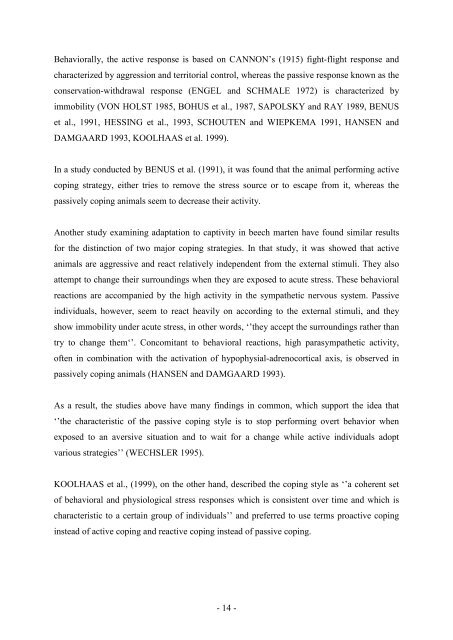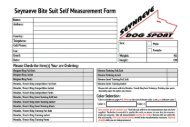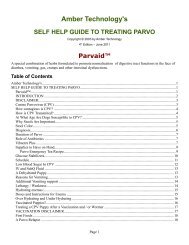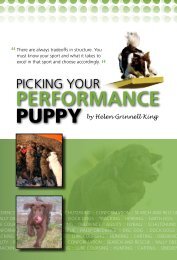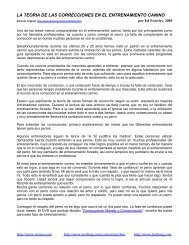Comparison of Stress and Learning Effects of Three Different ...
Comparison of Stress and Learning Effects of Three Different ...
Comparison of Stress and Learning Effects of Three Different ...
You also want an ePaper? Increase the reach of your titles
YUMPU automatically turns print PDFs into web optimized ePapers that Google loves.
Behaviorally, the active response is based on CANNON’s (1915) fight-flight response <strong>and</strong><br />
characterized by aggression <strong>and</strong> territorial control, whereas the passive response known as the<br />
conservation-withdrawal response (ENGEL <strong>and</strong> SCHMALE 1972) is characterized by<br />
immobility (VON HOLST 1985, BOHUS et al., 1987, SAPOLSKY <strong>and</strong> RAY 1989, BENUS<br />
et al., 1991, HESSING et al., 1993, SCHOUTEN <strong>and</strong> WIEPKEMA 1991, HANSEN <strong>and</strong><br />
DAMGAARD 1993, KOOLHAAS et al. 1999).<br />
In a study conducted by BENUS et al. (1991), it was found that the animal performing active<br />
coping strategy, either tries to remove the stress source or to escape from it, whereas the<br />
passively coping animals seem to decrease their activity.<br />
Another study examining adaptation to captivity in beech marten have found similar results<br />
for the distinction <strong>of</strong> two major coping strategies. In that study, it was showed that active<br />
animals are aggressive <strong>and</strong> react relatively independent from the external stimuli. They also<br />
attempt to change their surroundings when they are exposed to acute stress. These behavioral<br />
reactions are accompanied by the high activity in the sympathetic nervous system. Passive<br />
individuals, however, seem to react heavily on according to the external stimuli, <strong>and</strong> they<br />
show immobility under acute stress, in other words, ‘’they accept the surroundings rather than<br />
try to change them‘’. Concomitant to behavioral reactions, high parasympathetic activity,<br />
<strong>of</strong>ten in combination with the activation <strong>of</strong> hypophysial-adrenocortical axis, is observed in<br />
passively coping animals (HANSEN <strong>and</strong> DAMGAARD 1993).<br />
As a result, the studies above have many findings in common, which support the idea that<br />
‘’the characteristic <strong>of</strong> the passive coping style is to stop performing overt behavior when<br />
exposed to an aversive situation <strong>and</strong> to wait for a change while active individuals adopt<br />
various strategies’’ (WECHSLER 1995).<br />
KOOLHAAS et al., (1999), on the other h<strong>and</strong>, described the coping style as ‘’a coherent set<br />
<strong>of</strong> behavioral <strong>and</strong> physiological stress responses which is consistent over time <strong>and</strong> which is<br />
characteristic to a certain group <strong>of</strong> individuals’’ <strong>and</strong> preferred to use terms proactive coping<br />
instead <strong>of</strong> active coping <strong>and</strong> reactive coping instead <strong>of</strong> passive coping.<br />
- 14 -


